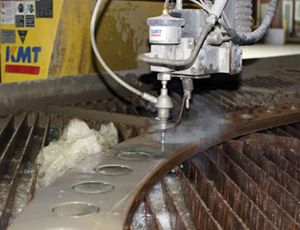
As one would assume, cutting steel plate is not a simple task. Known for its durability, traditional cutting methods such as sawing are simply incapable of creating smooth edges and the high precision cuts to steel plate demanded by professionals.
In fact, there are many work fields that depend on accuracy in terms of steel plate cutting. Contractors and builders as well as artists and hobbyists, to name but a few, require high precision when it comes to any material cutting, steel plate included.
Therefore, advanced methods need to be applied over old techniques. Two of the most commonly used steel plate cutting techniques are water jet cutting and plasma cutting.
What is Water Jet Cutting?
When considering the durability of steel plate, it may initially sound ludicrous to someone that water jet cutting is considered a highly efficient means of cutting through this material. How can water be strong enough to cut through steel plate?
Water jet cutting employs a mixture of water and an abrasive substance such as sand or garnet. This substance is combined with compressed air and shot out of a concentrated space (a nozzle) at a velocity and speed of up to three times the speed of sound. It is the abrasive substance that is responsible for the cutting and this is a highly effective means of cutting steel plate, along with other heavy-duty materials such as the following:
-
Brass
-
Stainless Steel
-
Plastic
-
Rubber
-
Glass
-
Aluminum
-
Granite
-
Marble
-
Stone
Computer-generated designs are applied to the material in question by a robotic arm. Due to the multi-axis and flexibility of the water jet stream, high accuracy levels are achieved and water jet cutting can also be used to create three-dimensional designs and a wide variety of intricate shapes.
Industries such as home renovation, contracting, construction, engineering and mining all rely on water jet cutting for its ability to cut a wide range of materials that will suffer thermal stress when in contact with intense heat.
Plasma cutting techniques are also used to cut steel plate and other heavy-duty materials. Plasma is an ionized gas in its fourth state. When electricity is applied to plasma, it heats up creating a strong cutting force that is able to cut through electrically conductive materials such as steel plate, copper and aluminum.
Plasma cutting offers several advantages over other cutting methods. It has the ability to gouge and pierce materials, as well as achieve high levels of accuracy and fine cuts. Less materials end up wasted, as plasma is able to achieve smooth cuts with no burring, warping or deformities.
To further its practicality, plasma cutting can be done by nearly anyone who understands the fundamentals of working with steel. Due to advancements in technology, handheld plasma arc devices have made it easy to complete steel plate cutting jobs in small garages and personal workshops, along with in larger factories.